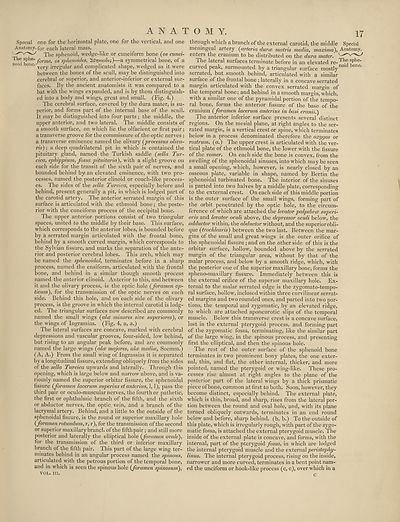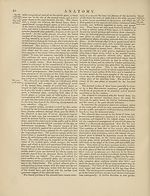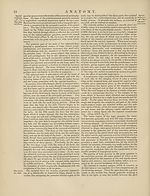Encyclopaedia Britannica > Volume 3, Anatomy-Astronomy
(25) Page 17
Download files
Complete book:
Individual page:
Thumbnail gallery: Grid view | List view

ANATOMY.
Special one for the horizontal plate, one for the vertical, and one
Anatomy.for each lateral mass.
The sphenoid, wedge-like or cuneiform bone (os cunei-
n In forme, os sphenoides, Kprjvoubn;)—a symmetrical bone, of a
111)11 )0rie' very irregular and complicated shape, wedged as it were
between the bones of the scull, may be distinguished into
cerebral or superior, and anterior-inferior or external sur¬
faces. By the ancient anatomists it was compared to a
bat with the wings expanded, and is by them distinguish¬
ed into a body and wings, great and small. (Fig. 4.)
The cerebral surface, covered by the dura mater, is su¬
perior, and forms part of the internal base of the scull.
It may be distinguished into four parts; the middle, the
upper anterior, and two lateral. The middle consists of
a smooth surface, on which lie the olfacient or first pair;
a transverse groove for the commissure of the optic nerves ;
a transverse eminence named the olivary (processus oliva-
ris); a deep quadrilateral pit in which is contained the
pituitary gland, named the Turkish saddle (sella Tur¬
cica, ephippium, fossa pituitaria), with a slight groove on
each side for the transit of the sixth pair of nerves, and
bounded behind by an elevated eminence, with two pro¬
cesses, named the posterior clinoid or couch-like process¬
es. The sides of the sella Turcica, especially before and
behind, present generally a pit, in which is lodged part of
the carotid artery. The anterior serrated margin of this
surface is articulated with the ethmoid bone; the poste¬
rior with the cuneiform process of the occipital bone.
The upper anterior portions consist of two triangular
spaces, united to the middle by their base. This surface,
which corresponds to the anterior lobes, is bounded before
by a serrated margin articulated with the frontal bone,
behind by a smooth curved margin, which corresponds to
the Sylvian fissure, and marks the separation of the ante¬
rior and posterior cerebral lobes. This arch, which may
be named the sphenoidal, terminates before in a sharp
process, named the ensiform, articulated with the frontal
bone, and behind in a similar though smooth process
named the anterior clinoid. Anterior to this, and between
it and the olivary process, is the optic hole (foramen op-
ticum), for the transmission of the optic nerves on each
side. Behind this hole, and on each side of the olivary
process, is the groove in which the internal carotid is lodg¬
ed. The triangular surfaces now described are commonly
named the small wings (alee minores sive superiores), or
the wings of Ingrassias. (Fig. 4, a, a.)
The lateral surfaces are concave, marked with cerebral
depressions and vascular grooves, four-sided, low behind,
but rising to an angular peak before, and are commonly
named the large wings (alee majores, alee medice, Soemm.)
(A, A.) From the small wing of Ingrassias it is separated
by a longitudinal fissure, extending obliquely from the sides
of the sella Turcica upwards and laterally. Through this
opening, which is large below and narrow above, and is va¬
riously named the superior orbitar fissure, the sphenoidal
fissure (foramen lacerum superius et anterius, 1,1), pass the
third pair or oculo-muscular nerves, the fourth or pathetic,
the first or ophthalmic branch of the fifth, and the sixth
or abductor nerves, the optic vein, and a branch of the
lacrymal artery. Behind, and a little to the outside of the
sphenoidal fissure, is the round or superior maxillary hole
(foramen rotundum, r, r), for the transmission of the second
or superior maxillary branch of the fifth pair ; and still more
posterior and laterally the elliptical hole (foramen ovale),
for the transmission of the third or interior maxillary
branch of the fifth pair. This part of the large wing ter¬
minates behind in an angular process named the spinous,
articulated with the petrous portion of the temporal bone,
and in which is seen the spinous hole (foranmi spinosum),
YOL. in.
17
through which a branch of the external carotid, the middle Special
meningeal artery (arteria durce matris media, maxima), Anatomy,
enters the cranium to be distributed on the dura mater,
The lateral surfaces terminate before in an elevated re- ^ ^ sphe-
cm ved peak, surmounted by a triangular surface mostly n°U >oru ‘
seriated, but smooth behind, articulated with a similar
surface of the fiontal bone \ laterally in a concave serrated
margin articulated with the convex serrated margin of
the temporal bone; and behind in a smooth margin, which,
with a similar one of the pyramidal portion of the tempo¬
ral bone, forms the anterior fissure of the base of the
cranium (foramen lacerum anterius in hasi cranii.)
The anterior inferior surface presents several distinct
regions. On the mesial plane, at right angles to the ser¬
rated margin, is a vertical crest or spine, which terminates
below in a process denominated therefore the azygos or
rostrum, (of) The upper crest is articulated with the ver¬
tical plate of the ethmoid bone, the lower with the fissure
of the vomer. On each side the bone is convex, from the
swelling of the sphenoidal sinuses, into which may be seen
a small opening, which, however, is nearly closed by an
osseous plate, variable in shape, named by Bertin the
sphenoidal turbinated bone. The interior of the sinuses
is parted into two halves by a middle plate, corresponding
to the external crest. On each side of this middle portion
is the outer surface of the small wings, forming part of
the orbit penetrated by the optic hole, to the circum¬
ference of which are attached the levator palpehrce superi-
oris and levator oculi above, the depressor oculi below, the
adductor within, the abductor without, and the superiorobli-
que (trochlearis) between the two last. Between the mar¬
gins of the small and great wings is the outer orifice of
the sphenoidal fissure ; and on the other side of this is the
orbitar surface, hollow, bounded above by the serrated
margin of the triangular area, without by that of the
malar process, and below by a smooth ridge, which, with
the posterior one of the superior maxillary bone, forms the
spheno-maxillary fissure. Immediately between this is
the external orifice of the superior maxillary hole. Ex¬
ternal to the malar serrated edge is the zygomato-tempo-
ral surface, hollow, inclosed within three curvilinear serrat¬
ed margins and two rounded ones, and parted into two por¬
tions, the temporal and zygomatic, by an elevated ridge,
to which are attached aponeurotic slips of the temporal
muscle. Below this transverse crest is a concave surface,
lost in the external pterygoid process, and forming part
of the zygomatic fossa, terminating, like the similar part
of the large wing, in the spinous process, and presenting
first the elliptical, and then the spinous hole.
The rest of the outer surface of the sphenoid bone
terminates in two prominent bony plates, the one exter¬
nal, thin, and flat, the other internal, thicker, and more
pointed, named the pterygoid or wing-like. These pro¬
cesses rise almost at right angles to the plane of the
posterior part of the lateral wings by a thick prismatic
piece of bone, common at first to both. Soon, however, they
become distinct, especially behind. The external plate,
which is thin, broad, and sharp, rises from the lateral por¬
tion between the round and oval hole, and, with its plane
turned obliquely outwards, terminates in an end round
below and before, sharp behind, (b, b.) To the outside of
this plate, which is irregularly rough, with part of the zygo¬
matic fossa, is attached the external pterygoid muscle. The
inside of the external plate is concave, and forms, with the
internal, part of the pterygoid fossa, in which are lodged
the internal pterygoid muscle and the external peristaphy-
linus. The internal pterygoid process, rising on the inside,
narrower and more curved, terminates in a bent point nam¬
ed the unciform or hook-like process (c, c), over which in a
Special one for the horizontal plate, one for the vertical, and one
Anatomy.for each lateral mass.
The sphenoid, wedge-like or cuneiform bone (os cunei-
n In forme, os sphenoides, Kprjvoubn;)—a symmetrical bone, of a
111)11 )0rie' very irregular and complicated shape, wedged as it were
between the bones of the scull, may be distinguished into
cerebral or superior, and anterior-inferior or external sur¬
faces. By the ancient anatomists it was compared to a
bat with the wings expanded, and is by them distinguish¬
ed into a body and wings, great and small. (Fig. 4.)
The cerebral surface, covered by the dura mater, is su¬
perior, and forms part of the internal base of the scull.
It may be distinguished into four parts; the middle, the
upper anterior, and two lateral. The middle consists of
a smooth surface, on which lie the olfacient or first pair;
a transverse groove for the commissure of the optic nerves ;
a transverse eminence named the olivary (processus oliva-
ris); a deep quadrilateral pit in which is contained the
pituitary gland, named the Turkish saddle (sella Tur¬
cica, ephippium, fossa pituitaria), with a slight groove on
each side for the transit of the sixth pair of nerves, and
bounded behind by an elevated eminence, with two pro¬
cesses, named the posterior clinoid or couch-like process¬
es. The sides of the sella Turcica, especially before and
behind, present generally a pit, in which is lodged part of
the carotid artery. The anterior serrated margin of this
surface is articulated with the ethmoid bone; the poste¬
rior with the cuneiform process of the occipital bone.
The upper anterior portions consist of two triangular
spaces, united to the middle by their base. This surface,
which corresponds to the anterior lobes, is bounded before
by a serrated margin articulated with the frontal bone,
behind by a smooth curved margin, which corresponds to
the Sylvian fissure, and marks the separation of the ante¬
rior and posterior cerebral lobes. This arch, which may
be named the sphenoidal, terminates before in a sharp
process, named the ensiform, articulated with the frontal
bone, and behind in a similar though smooth process
named the anterior clinoid. Anterior to this, and between
it and the olivary process, is the optic hole (foramen op-
ticum), for the transmission of the optic nerves on each
side. Behind this hole, and on each side of the olivary
process, is the groove in which the internal carotid is lodg¬
ed. The triangular surfaces now described are commonly
named the small wings (alee minores sive superiores), or
the wings of Ingrassias. (Fig. 4, a, a.)
The lateral surfaces are concave, marked with cerebral
depressions and vascular grooves, four-sided, low behind,
but rising to an angular peak before, and are commonly
named the large wings (alee majores, alee medice, Soemm.)
(A, A.) From the small wing of Ingrassias it is separated
by a longitudinal fissure, extending obliquely from the sides
of the sella Turcica upwards and laterally. Through this
opening, which is large below and narrow above, and is va¬
riously named the superior orbitar fissure, the sphenoidal
fissure (foramen lacerum superius et anterius, 1,1), pass the
third pair or oculo-muscular nerves, the fourth or pathetic,
the first or ophthalmic branch of the fifth, and the sixth
or abductor nerves, the optic vein, and a branch of the
lacrymal artery. Behind, and a little to the outside of the
sphenoidal fissure, is the round or superior maxillary hole
(foramen rotundum, r, r), for the transmission of the second
or superior maxillary branch of the fifth pair ; and still more
posterior and laterally the elliptical hole (foramen ovale),
for the transmission of the third or interior maxillary
branch of the fifth pair. This part of the large wing ter¬
minates behind in an angular process named the spinous,
articulated with the petrous portion of the temporal bone,
and in which is seen the spinous hole (foranmi spinosum),
YOL. in.
17
through which a branch of the external carotid, the middle Special
meningeal artery (arteria durce matris media, maxima), Anatomy,
enters the cranium to be distributed on the dura mater,
The lateral surfaces terminate before in an elevated re- ^ ^ sphe-
cm ved peak, surmounted by a triangular surface mostly n°U >oru ‘
seriated, but smooth behind, articulated with a similar
surface of the fiontal bone \ laterally in a concave serrated
margin articulated with the convex serrated margin of
the temporal bone; and behind in a smooth margin, which,
with a similar one of the pyramidal portion of the tempo¬
ral bone, forms the anterior fissure of the base of the
cranium (foramen lacerum anterius in hasi cranii.)
The anterior inferior surface presents several distinct
regions. On the mesial plane, at right angles to the ser¬
rated margin, is a vertical crest or spine, which terminates
below in a process denominated therefore the azygos or
rostrum, (of) The upper crest is articulated with the ver¬
tical plate of the ethmoid bone, the lower with the fissure
of the vomer. On each side the bone is convex, from the
swelling of the sphenoidal sinuses, into which may be seen
a small opening, which, however, is nearly closed by an
osseous plate, variable in shape, named by Bertin the
sphenoidal turbinated bone. The interior of the sinuses
is parted into two halves by a middle plate, corresponding
to the external crest. On each side of this middle portion
is the outer surface of the small wings, forming part of
the orbit penetrated by the optic hole, to the circum¬
ference of which are attached the levator palpehrce superi-
oris and levator oculi above, the depressor oculi below, the
adductor within, the abductor without, and the superiorobli-
que (trochlearis) between the two last. Between the mar¬
gins of the small and great wings is the outer orifice of
the sphenoidal fissure ; and on the other side of this is the
orbitar surface, hollow, bounded above by the serrated
margin of the triangular area, without by that of the
malar process, and below by a smooth ridge, which, with
the posterior one of the superior maxillary bone, forms the
spheno-maxillary fissure. Immediately between this is
the external orifice of the superior maxillary hole. Ex¬
ternal to the malar serrated edge is the zygomato-tempo-
ral surface, hollow, inclosed within three curvilinear serrat¬
ed margins and two rounded ones, and parted into two por¬
tions, the temporal and zygomatic, by an elevated ridge,
to which are attached aponeurotic slips of the temporal
muscle. Below this transverse crest is a concave surface,
lost in the external pterygoid process, and forming part
of the zygomatic fossa, terminating, like the similar part
of the large wing, in the spinous process, and presenting
first the elliptical, and then the spinous hole.
The rest of the outer surface of the sphenoid bone
terminates in two prominent bony plates, the one exter¬
nal, thin, and flat, the other internal, thicker, and more
pointed, named the pterygoid or wing-like. These pro¬
cesses rise almost at right angles to the plane of the
posterior part of the lateral wings by a thick prismatic
piece of bone, common at first to both. Soon, however, they
become distinct, especially behind. The external plate,
which is thin, broad, and sharp, rises from the lateral por¬
tion between the round and oval hole, and, with its plane
turned obliquely outwards, terminates in an end round
below and before, sharp behind, (b, b.) To the outside of
this plate, which is irregularly rough, with part of the zygo¬
matic fossa, is attached the external pterygoid muscle. The
inside of the external plate is concave, and forms, with the
internal, part of the pterygoid fossa, in which are lodged
the internal pterygoid muscle and the external peristaphy-
linus. The internal pterygoid process, rising on the inside,
narrower and more curved, terminates in a bent point nam¬
ed the unciform or hook-like process (c, c), over which in a
Set display mode to:
![]() Universal Viewer |
Universal Viewer | ![]() Mirador |
Large image | Transcription
Mirador |
Large image | Transcription
Images and transcriptions on this page, including medium image downloads, may be used under the Creative Commons Attribution 4.0 International Licence unless otherwise stated. ![]()
| Encyclopaedia Britannica > Encyclopaedia Britannica > Volume 3, Anatomy-Astronomy > (25) Page 17 |
|---|
| Permanent URL | https://digital.nls.uk/193757673 |
|---|
| Attribution and copyright: |
|
|---|---|
| Shelfmark | EB.16 |
|---|---|
| Description | Ten editions of 'Encyclopaedia Britannica', issued from 1768-1903, in 231 volumes. Originally issued in 100 weekly parts (3 volumes) between 1768 and 1771 by publishers: Colin Macfarquhar and Andrew Bell (Edinburgh); editor: William Smellie: engraver: Andrew Bell. Expanded editions in the 19th century featured more volumes and contributions from leading experts in their fields. Managed and published in Edinburgh up to the 9th edition (25 volumes, from 1875-1889); the 10th edition (1902-1903) re-issued the 9th edition, with 11 supplementary volumes. |
|---|---|
| Additional NLS resources: |
|

